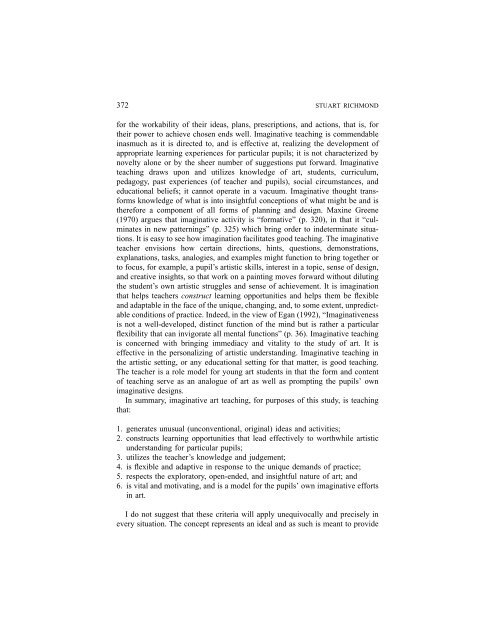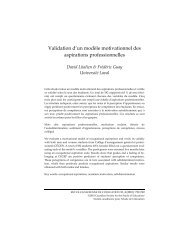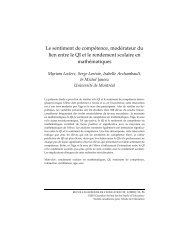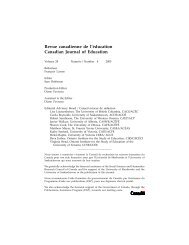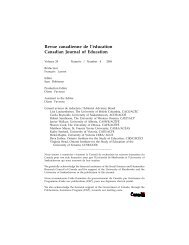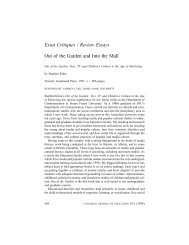Mireille Falardeau et Michel Loranger Le choix de stratégies ... - CSSE
Mireille Falardeau et Michel Loranger Le choix de stratégies ... - CSSE
Mireille Falardeau et Michel Loranger Le choix de stratégies ... - CSSE
Create successful ePaper yourself
Turn your PDF publications into a flip-book with our unique Google optimized e-Paper software.
372 STUART RICHMOND<br />
for the workability of their i<strong>de</strong>as, plans, prescriptions, and actions, that is, for<br />
their power to achieve chosen ends well. Imaginative teaching is commendable<br />
inasmuch as it is directed to, and is effective at, realizing the <strong>de</strong>velopment of<br />
appropriate learning experiences for particular pupils; it is not characterized by<br />
novelty alone or by the sheer number of suggestions put forward. Imaginative<br />
teaching draws upon and utilizes knowledge of art, stu<strong>de</strong>nts, curriculum,<br />
pedagogy, past experiences (of teacher and pupils), social circumstances, and<br />
educational beliefs; it cannot operate in a vacuum. Imaginative thought transforms<br />
knowledge of what is into insightful conceptions of what might be and is<br />
therefore a component of all forms of planning and <strong>de</strong>sign. Maxine Greene<br />
(1970) argues that imaginative activity is “formative” (p. 320), in that it “culminates<br />
in new patternings” (p. 325) which bring or<strong>de</strong>r to ind<strong>et</strong>erminate situations.<br />
It is easy to see how imagination facilitates good teaching. The imaginative<br />
teacher envisions how certain directions, hints, questions, <strong>de</strong>monstrations,<br />
explanations, tasks, analogies, and examples might function to bring tog<strong>et</strong>her or<br />
to focus, for example, a pupil’s artistic skills, interest in a topic, sense of <strong>de</strong>sign,<br />
and creative insights, so that work on a painting moves forward without diluting<br />
the stu<strong>de</strong>nt’s own artistic struggles and sense of achievement. It is imagination<br />
that helps teachers construct learning opportunities and helps them be flexible<br />
and adaptable in the face of the unique, changing, and, to some extent, unpredictable<br />
conditions of practice. In<strong>de</strong>ed, in the view of Egan (1992), “Imaginativeness<br />
is not a well-<strong>de</strong>veloped, distinct function of the mind but is rather a particular<br />
flexibility that can invigorate all mental functions” (p. 36). Imaginative teaching<br />
is concerned with bringing immediacy and vitality to the study of art. It is<br />
effective in the personalizing of artistic un<strong>de</strong>rstanding. Imaginative teaching in<br />
the artistic s<strong>et</strong>ting, or any educational s<strong>et</strong>ting for that matter, is good teaching.<br />
The teacher is a role mo<strong>de</strong>l for young art stu<strong>de</strong>nts in that the form and content<br />
of teaching serve as an analogue of art as well as prompting the pupils’ own<br />
imaginative <strong>de</strong>signs.<br />
In summary, imaginative art teaching, for purposes of this study, is teaching<br />
that:<br />
1. generates unusual (unconventional, original) i<strong>de</strong>as and activities;<br />
2. constructs learning opportunities that lead effectively to worthwhile artistic<br />
un<strong>de</strong>rstanding for particular pupils;<br />
3. utilizes the teacher’s knowledge and judgement;<br />
4. is flexible and adaptive in response to the unique <strong>de</strong>mands of practice;<br />
5. respects the exploratory, open-en<strong>de</strong>d, and insightful nature of art; and<br />
6. is vital and motivating, and is a mo<strong>de</strong>l for the pupils’ own imaginative efforts<br />
in art.<br />
I do not suggest that these criteria will apply unequivocally and precisely in<br />
every situation. The concept represents an i<strong>de</strong>al and as such is meant to provi<strong>de</strong>


